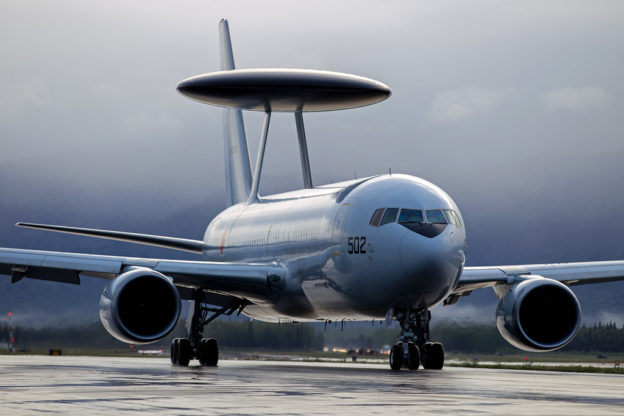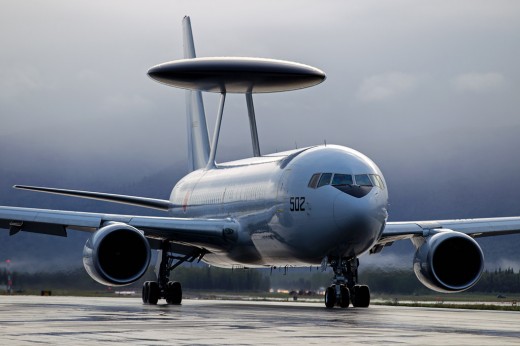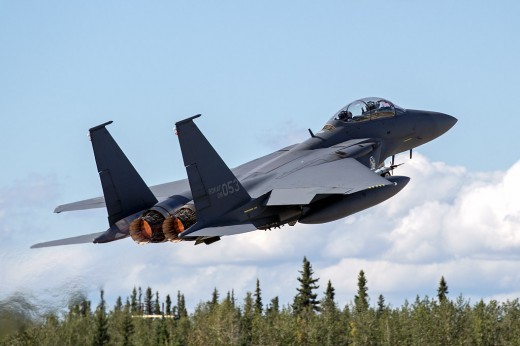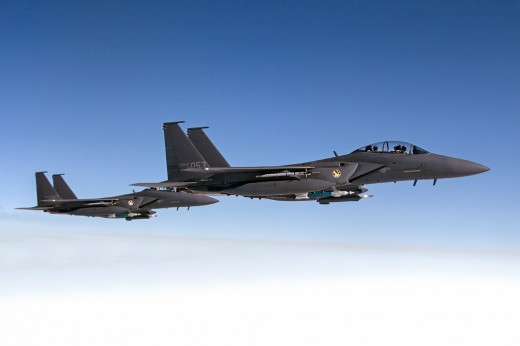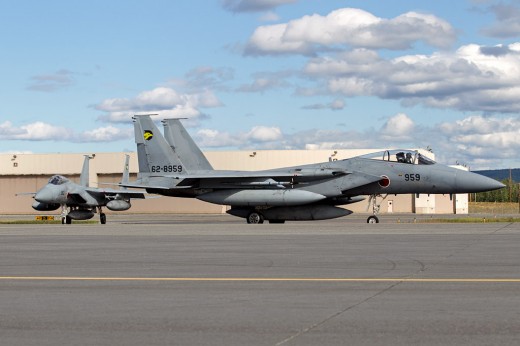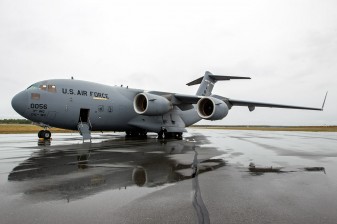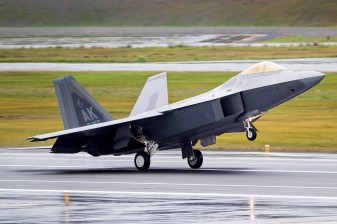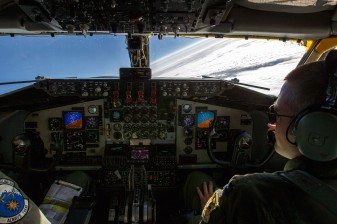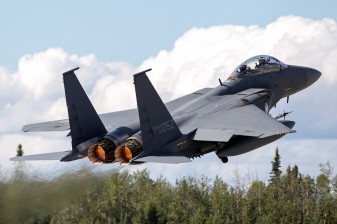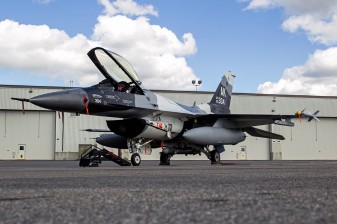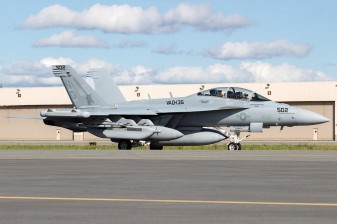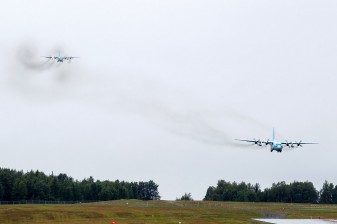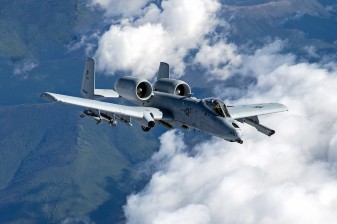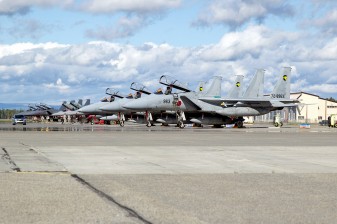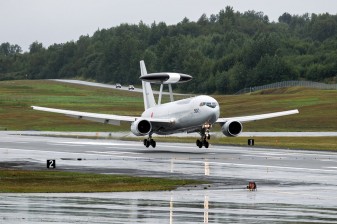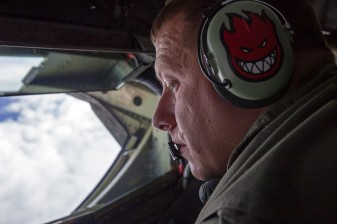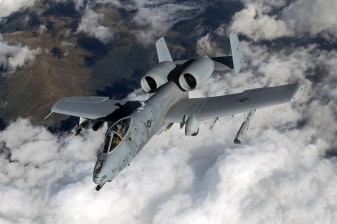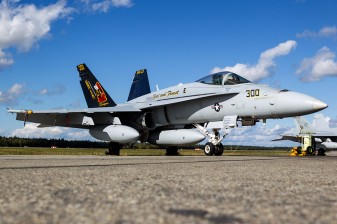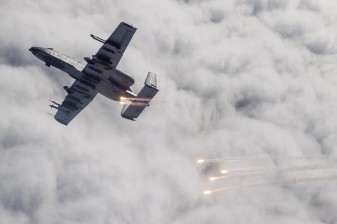
Red Flag Alaska 13-3
|
The cold north
Most who know about Red Flag will associate it with Nellis AFB just outside Las Vegas and the Nellis ranges in the Nevada desert and mountains. But it is not only here that Red Flag exercises take place. Red Flag – Alaska is similar to the Red Flag held at Nellis AFB, in other words, a multi-service, multinational air combat exercise. The exercise is under the control of the Pacific Air Forces in the U.S. Air Force. The exercise was originally known as Cope Thunder and began in 1976 at Clark Air Base in the Philippines. After the eruption of Mount Pinatubo in 1992, Cope Thunder moved to Eielson Air Force Base in Alaska and in 2006 was renamed Red Flag – Alaska.
|
“Analysis has shown that most air combat losses occur during the first eight to ten missions.”
Red and blue
Red Flag – Alaska mission planners take these factors into consideration when the exercise is planned and organized so that the participants get the maximum amount of training without being treated less favourably than their opponents in the simulated combat scenarios.
Red Flag – Alaska participants are organized into a “Red” aggressor force, a “Blue” coalition force and a “White” neutral force that represents the neutral controlling units. “Red Force” includes air-to-air fighters, ground-control interception units and surface to air units to simulate threats from potentially hostile nations. These forces generally use defensive counter-air tactics directed by ground-control intercept sites. Range threat emitters, electronic devices that send out signals to simulate anti-aircraft artillery and surface-to-air missiles, provide valuable ground-to-air threat training for the pilots. “Blue Force” includes the full spectrum of U.S. and allied tactical and support units. When “Red” and “Blue” force meet in the simulated combat training area, the job of managing this simulated war and making sure everything is as safe as possible falls to the “White” neutral force. On average, more than 1.000 people, and up to sixty aircraft are stationed at Eielson Air Force Base and a further 500 people and forty aircraft are stationed at Joint Base Elmendorf-Richardson for each Red Flag – Alaska exercise. Most participating units for Red Flag–Alaska arrive a week before the actual exercise starts. In the time leading up to the exercise, the aircrews fly one or two training missions to familiarize themselves with the different ranges, get themselves physically and mentally prepared, read up on local flying restrictions and receive local safety and survival briefings. In the two-week active phase of the exercise, aircrews are exposed to every conceivable threat scenario. The scenarios are designed to meet specific training objectives for each exercise and all units are involved in the development of the exercise training objectives. At the peak of the exercise, up to seventy fighters will be in the air at the same time and for a typical Red Flag–Alaska, two combat training missions are conducted every day. |
|
|
|
|
The big airspace
All Red Flag – Alaska missions take place over the Joint Pacific Alaska Range Complex and in part of the western Canadian airspace. The entire airspace consists of extensive Military Operations Areas, Special Use Airspace and ranges. The overall airspace available for the exercise is over 170.000 square kilometres.
Since its inception, thousands of air and ground crews from all four branches of the U.S. military and the armed forces of several other countries around the world have participated in Red Flag – Alaska and Co-operative Cope Thunder exercises. In 2012, more than 5.000 people deployed to the Red Flag–Alaska exercise and participating aircrews flew over 4.000 sorties. Aircrews are not the only ones benefiting from the Red Flag – Alaska exercise. It provides an operational training environment for participants from unit-level intelligence, maintenance crews, command and control elements and many others. By providing diverse scenarios using common global threats and simulated combat conditions, Red Flag – Alaska gives everyone the chance to make the tough choices that are often required in combat. Because of the major economic problems in the United States, many units in the U.S. had been ordered to temporarily stand down which also meant that Red Flag – Alaska 2013 was initially cancelled. However, this was changed and the first and only Red Flag–Alaska exercise in 2013, was held in mid-August at the twin bases. More than sixty aircraft and 2,600 personnel from the U.S. Air Force’s active, Reserve and Air National Guard units, U.S. Army, U.S. Navy, Japanese Air Self-Defence Force, Royal Australian Air Force, Royal New Zealand Air Force and Republic of Korea Air Force took part in the two-week-long exercise, Red Flag – Alaska 13-3. |
“The entire airspace consists of extensive Military Operations Areas, Special Use Airspace and ranges. The overall airspace available for the exercise is over 170.000 square kilometres.
|
|
|
|
|
The Japanese and the Koreans
The exercise marked the first time Korean and Japanese forces had trained together, not only in Alaska, but anywhere in the world. The exercise also marked the first time that the Republic of Korea Air Force had flown their F-15K Slam Eagles all the way from South Korea across the Pacific.
Earlier, when the Republic of Korea Air Force participated in Red Flag at Nellis AFB with their F-15K Slam Eagles, the aircraft were brand new and came directly from Boeing’s plant in St. Louis. Japanese Air Self-Defence Force participated with their version of the F-15, the Mitsubishi F-15J Eagle, a Boeing E-767 AWACS, and three C-130 Hercules. The Royal Australian Air Force participated with two E-7A Wedgetail (Boeing 737 AEW & C). Other units participating in the Red Flag – Alaska 13-3 were:
|
|
|
|
|
|
Never leave an Airman behind
Red Flag – Alaska is not just about the two opposing forces meeting in simulated air combat. “Never leave an Airman behind” is the motto of the two U.S. Air Force HH-60 Pave Hawk helicopters from the 210th Rescue Squadron at Eielson Air Force Base, Alaska. During the exercise, they were sent to rescue a simulated downed pilot who was randomly chosen from one of the participating units.
A-10 Thunderbolt IIs from the 163th Fighter Squadron, Indiana Air National Guard based at Ft. Wayne, Indiana participated in the search for the downed pilot by first locating the him and then securing the area until the HH-60 Pave Hawk helicopters moved in for the safe pick-up. The last mission of the exercise was when one of the local C-17A Globemaster III from Joint Base Elmendorf-Richardson had to be escorted through hostile territory by the “Blue” force. The mission, in all its simplicity, was to protect the Globemaster so it could fly to a drop zone and drop support equipment for the ground forces. |
Two F-15J from JASDF, taxis out to start another mission during Red Flag Alaska 13-3.
The airdrop
After the airdrop, the Globemaster had to make a tactical landing on a dirt-field at Fort Greely to pick up some cargo, which in this instance was simulated by empty water barrels and finally return safely to Joint Base Elmendorf-Richardson.
A big thanks to MSgt. Jason M. Vaught, Public Affairs Eielson Air Force Base, SSgt Chris Huber, Kadena Air Force Base, and SSgt William Banton, Media Operations Specialist / NCOIC of Social Media Joint Base Elmendorf-Richardson for helping with the making of this article. |
|
|
|

